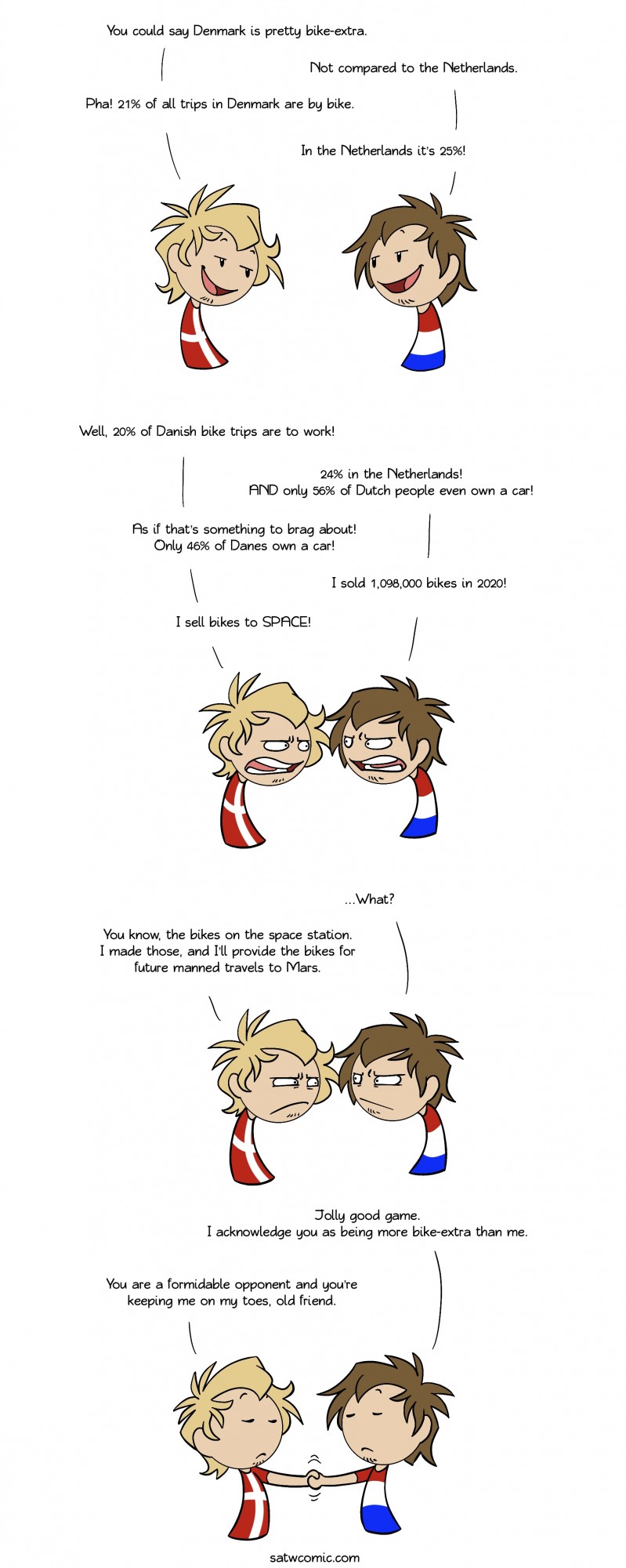
Lands of two wheels
When I learned that Denmark provides all exercise bikes in space I thought “That is so on brand for Denmark and how didn’t the Netherlands get that job?”
Netherlands Denmark
24th September 2022
3 years ago #9875633
7
0
There have been over a hundred pedal-powered aircraft, aka, flying bikes. None have been built in Denmark. Denmark, you gotta step up your game.
3 years ago #9876296
4
1
Meanwhile in the US
"I swear guys, just one more lane on the stroad and we'll fix traffic this time. Just one more."
"I swear guys, just one more lane on the stroad and we'll fix traffic this time. Just one more."
3 years ago #9875600
3
0
For people from the USA who look at bike infrastructure like that of the Danish and the Dutch thinking it's basically magic and you'll never get it;
It *is* possible. But there are a lot of things baked in that prevent this. Think lots of zoning laws; Euclidean zoning (land may only be used for 1 and 1 specific thing only as if it's a DOS adventure game item), minimum parking requirements, house needs to be a minimum away from the street (and sometimes other directions). But also think about the aversion to traffic calming in *any* way even if it makes things safer and faster even for drivers. The overabundance of traffic lights and stop signs. The fact that roundabouts are avoided better than the plague. Oh and no more turning right on red.
On top of that the flawed belief that adding more lanes fixes things even though every time a massive highway is widened it takes only a few months before travel times are longer than before the widening (i.e. Induced Demand). Plus the fact that there's profit to be made in car dependent infrastructure by multiple industries. Like those that build the infrastructure and those that sell the now 'required to live' cars.
If you were to ask me what had to change in 1 word, I'd say "culture" but personally I think that the 'culture' will follow once the changes have been made. As good infrastructure has shown us time and time again; build and they will follow. If your good infrastructure doesn't draw more people on their bikes; it wasn't good infrastructure.
It *is* possible. But there are a lot of things baked in that prevent this. Think lots of zoning laws; Euclidean zoning (land may only be used for 1 and 1 specific thing only as if it's a DOS adventure game item), minimum parking requirements, house needs to be a minimum away from the street (and sometimes other directions). But also think about the aversion to traffic calming in *any* way even if it makes things safer and faster even for drivers. The overabundance of traffic lights and stop signs. The fact that roundabouts are avoided better than the plague. Oh and no more turning right on red.
On top of that the flawed belief that adding more lanes fixes things even though every time a massive highway is widened it takes only a few months before travel times are longer than before the widening (i.e. Induced Demand). Plus the fact that there's profit to be made in car dependent infrastructure by multiple industries. Like those that build the infrastructure and those that sell the now 'required to live' cars.
If you were to ask me what had to change in 1 word, I'd say "culture" but personally I think that the 'culture' will follow once the changes have been made. As good infrastructure has shown us time and time again; build and they will follow. If your good infrastructure doesn't draw more people on their bikes; it wasn't good infrastructure.
3 years ago #9875699
2
0
Thought Denmark was going to win with the “cars cost 300% of their value in Denmark” argument.
3 years ago #9875592
1
1
If there were one thing I wish I could take from the Dutch and the Danes, it'd be the pro-cycling infrastructure. It is simply the most efficient way to get around a city -- lowest tax base needed for public infrastructure, keeps healthcare costs low, and so on.
Meanwhile my fellow countrymen drive their V8 oversized Cowboy Cadillacs to the gym to get on a treadmill, because apparently 93 in the shade is hot or something.
Meanwhile my fellow countrymen drive their V8 oversized Cowboy Cadillacs to the gym to get on a treadmill, because apparently 93 in the shade is hot or something.
Add comment: Please Sign in or create an accout to comment.



 Support the comic on
Support the comic on 





















27